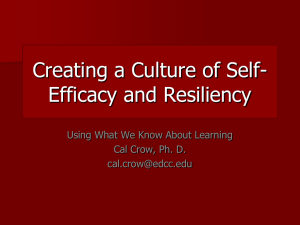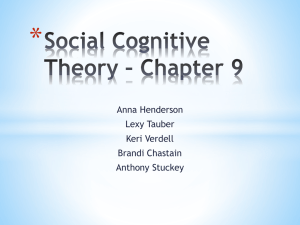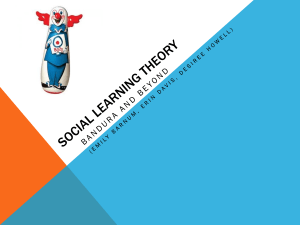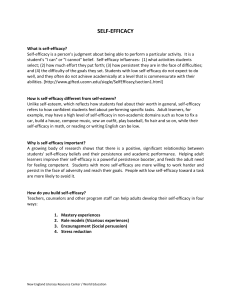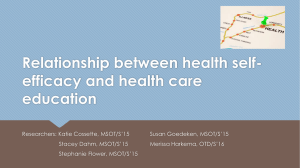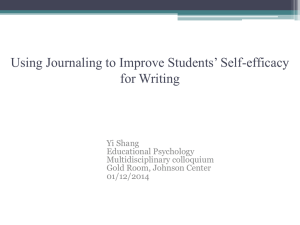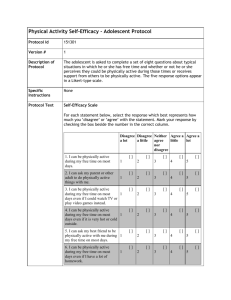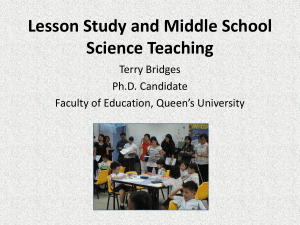Contextualized Measurement of Self- efficacy and College Students
advertisement
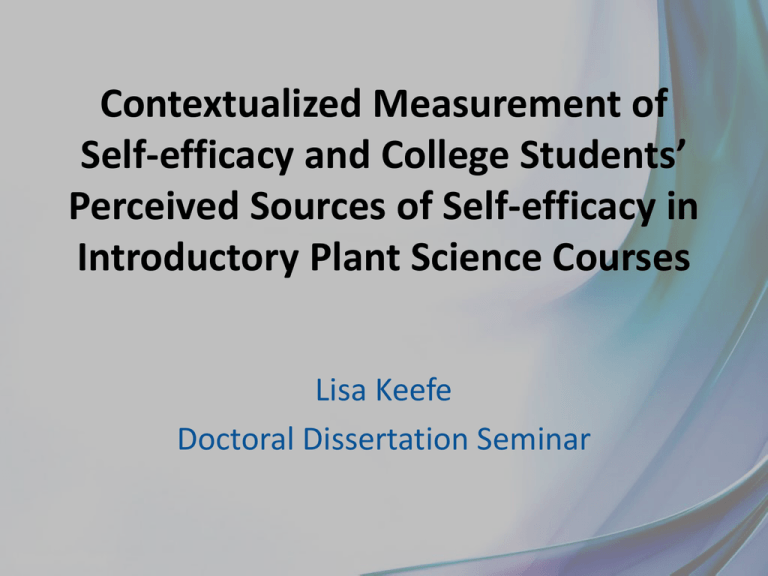
Contextualized Measurement of Self-efficacy and College Students’ Perceived Sources of Self-efficacy in Introductory Plant Science Courses Lisa Keefe Doctoral Dissertation Seminar Overview • • • • • • • Introduction Theoretical Framework Review of Literature Dissertation Conceptual Framework Study #1 Study #2 Implications for Practice Introduction Introductory Course Early Assessment Difficult Science Concepts Course Mastery Science Literacy & Career Theoretical Framework Mastery of SE: belief in • Bandura (1997)definition I do… Experience personal capabilities to organize and execute tasks required to produce specific results I hear… within a specific context Vicarious Social SE • 4 Sources of SE Experience Persuasion I see… Emotional Response I feel… Review of Literature • Self-efficacy (SE) = good predictor of academic performance. • SE has been studied in the sciences • Need for context-specific studies • Sources of SE also important but few existing studies (Usher, E. L., & Pajares, F. (2008). Sources of self-efficacy in school: Critical review of the literature and future directions. Review of Educational Research, 78(4), 751-796 Schunk, D., Pintrich, P. R., & Meece, J. (Eds.). (2007a). Motivation in dducation: Theory, research and applications (3rd ed.): Pearson. Klassen, R., & Usher, E. (2010). Self-efficacy in educational settings: Recent research and emerging directions. In S. Karabenick & T. Urdan (Eds.), Advances in motivation and achievement (Vol. 16a): Emerald Group Publishing Limited. Gore, P. A. (2006b). Academic self-efficacy as a predictor of dollege outcomes: Two incremental validity studies. Journal of Career Assessment, 14(1), 92-115. doi: 10.1177/1069072705281367 Conceptual Framework Contextual Investigation of SE Develop a Plant SE Instrument (Questionnaire) EFA n=248 CFA n=241 Exploring Sources of Plant SE (Qualitative) Short-answer (initial coding) n=200+ Interviews (Provisional Coding) n=4 Literature (Triangulation) Study 1-Measuring Self-efficacy • • • • • • Current Instruments Participants Development Data collection and analysis Results Limitations Measuring Plant SE (Instrument Development) EFA n=248 CFA n=241 Current Instruments College BiologyQuestionnaire Self• CBSI Science Motivation (Glynn, Taasoobshirazi, & efficacy Instrument Brickman, 2009) (Baldwin • Science Literacy item ideas et al., 1999) CAEQ Chemistry Attitudes & Experiences Questionnaire (Dalgety et al., 2003) • Lab/experiment skills wording CCSS College Chemistry Selfefficacy Scale (Uzuntiryaki et al., 2009) • Concept and skill understanding at the chemistry NOT course level Baldwin, J. A., Ebert-May, D., & Burns, D. J. (1999). The development of a college biology self-efficacy instrument for nonmajors. Science Education, 83(4), 397-408. Glynn, S. M., Taasoobshirazi, G., & Brickman, P. (2009). Science Motivation Questionnaire: Construct validation with nonscience majors. Journal of Research in Science Teaching, 46(2), 127-146. doi: 10.1002/tea.20267 Dalgety, J., Coll, R. K., & Jones, A. (2003). Development of chemistry attitudes and experiences questionnaire (CAEQ). Journal of Research in Science Teaching, 40(7), 649-668 Uzuntiryaki, E., & Çapa Aydın, Y. (2009). Development and Validation of Chemistry Self-Efficacy Scale for College Students. Research in Science Education, 39(4), 539551. Participants HORT 101, BTNY 110 & AGRY 105 major (M), science major (SM) and non-science major (NSM) EFA:Spring 2012 (n=248) • M=20% • SM=32% • NSM=48% CFA:Fall 2012 (n=241) • M=24% • SM=19% • NSM=57% 80% White/caucasian & 50% male/female ratio Development Expert Defined Dimensions for Successful Study in Introductory Plant Science Courses Life Science Research & Literacy Plant Sciences Experimenting/applying research Terminology/diagram use Terminology/diagram use Genetics Genetics Environmental Responses Life processes Plant Concept specific - Photosynthesis Respiration Plant Scientists Education Researchers Kathryn Orvis, Horticulture Neil Knobloch Michael Zanis, Botany Bryan Hains Lori Snyder, Agronomy Mark Balschweid Future Outcomes Life understanding of biology Data Collection and Analysis • Students told about the research before participating. Also asked if concurrently enrolled and not to fill out questionnaire twice • 1st group factor analysis (EFA) • 2nd group confirmatory factor analysis (CFA) EFA Results PCSE • 7 items; 48% variance • Students’ beliefs in the ability to navigate core plant biology concepts • Photosynthesis/Respiration/Reproduction ect. GSSE • 5 items; 10% variance • Students’ beliefs in their ability to perform basic skills common to most science fields • Scientific processes/experimentation MSSE • 6 items; 8% variance • Students’ beliefs in their ability have mastered life science tasks and concepts well enough to use them for life. • Expertise as a life scientist Factor Pattern Matrix for Plant Science Self-efficacy Items Item Explain the role of water in plant respiration. Explain how weeds could become resistant to herbicides. Explain how a plant produces food and uses energy. Predict how a plant will respond to a given environmental condition. Explain the process of pollination in plants to produce fruit. Recall the anatomy of a plant. Explain the role of light in photosynthesis. Instruct a classmate on how to write an experiment report. Ask a research question that could be answered experimentally. Critique an experiment in a scientific paper. Conduct an experiment on your own after reading the experimental procedures. Research the scientific facts in a common news story for accuracy of the claims. Achieve success in this life science course. Graduate with a life science degree. Master the plant biology skills taught in this course. Tutor another student in a 1st year life science course. Use concepts of life science in solving everyday problems at home. Use correct biological terminology to explain a concept to a scientist. Eigen Values Cronbach’s α PC .82 .49 .85 .66 .70 .66 .78 .04 .07 .04 .09 GS .06 .05 .01 .29 .05 .02 .01 .79 .70 .85 .46 MS .05 .25 .02 .14 .17 .19 .03 .04 .01 .05 .25 0.18 .62 .04 .25 .04 .25 .11 .05 .01 8.70 0.91 .67 .59 .51 .86 .69 .57 1.41 0.88 .07 .05 .00 .11 .20 .25 1.82 0.87 ITEM8 e8 ITEM9 e9 ITEM10 e10 ITEM11 e11 ITEM12 e12 ITEM1 e1 ITEM2 e2 ITEM3 e3 ITEM4 e4 ITEM5 e5 ITEM6 e6 ITEM7 e7 ITEM13 e13 ITEM14 e14 .84 ITEM15 e15 .66 ITEM16 e16 ITEM17 e17 .72 CFI (0.92) RMSEA (0.08) GFI (0.88) .83 GS GSSE .66 .61 .61 .61 .79 .67 .66 PCSE PC .82 .68 .68 .69 .67 PCSE .71 7 Items .71 MSSE GSSE 5 Items 5 Items .75 MS MSSE .64 Please rate how confident you are in your ability to perform the following tasks today. 1) Not at all confident 2) Slightly confident 3) Somewhat confident 4) Mostly confident 5) Extremely confident PCSE •Explain how a plant produces food and uses energy. •Predict how a plant will respond to a given environmental condition. GSSE •Instruct a classmate on how to write an experiment report. •Ask a research question that could be answered experimentally. MSSE •Use concepts of life science in solving everyday problems at home. •Tutor another student in a 1st year life science course. Limitations and Recommendations • Minimally adequate model fit • Small # of students • Demographics (High non-science majors/low racial diversity) For Practice • Measures SE of core (lynchpin) plant science concepts • Measures SE of translatable science skills • Fills a need for SE questionnaire aimed at core plant science concepts/skills and may have use in any introductory plant science class Study 2-Sources of Self-efficacy in an introductory plant science class • • • • Participants Deductive analysis Results Limitations Exploring Sources of Plant SE (Qualitative) Short-answer (initial coding) n=200+ Interviews (Provisional Coding) n=4 Literature (Triangulation) Participants Short-answer (n=>200) • 200+ students enrolled in HORT 101, AGRY 105 or BTNY 110 • Spring semester 2012 and Fall 2012 Interview-Fall semester 2012 (n=4) • 2 Landscape Architecture majors – Alice had taken a plant biology dual-credit course – Melinda’s parents own a landscaping company • 2 Agricultural Education majors – Rose had little experience but parents dabbled in row crops – Adam had an interest in gardening Deductive Analysis Realism assumes a single, blurry reality; therefore, we made every effort to triangulate our data in Literature order to illustrate a single, complex reality as experienced through context and perception (Sobh & Perry, 2006). Shortanswer Interviews Short-answer • Please rate how confident you are in your ability to perform the following tasks as of today— 1) Achieve success in another life science class 2) Receive good grades on exams in this course • “Think about the reasons you considered when answering the question above. Describe briefly all of the reasons on which you based your confidence rating to this particular question. Include everything that comes to mind in the spaces provided.” Hutchison, M. A., Follman, D. K., Sumpter, M., & Bodner, G. M. (2006). Factors influencing the self-efficacy beliefs of first-year engineering students. Journal of Engineering Education, 39-47. Results of Short-answer and Interviews Self reported influences SA I Studying Previous grade performance Completion of assignments Background knowledge/experience Conceptual understanding Class attendance Teaching methods Perception of teacher Classmate interactions Bandura (1997) Sources of Self-efficacy Negative feelings Learning ability Interest Required for major Mastery Experiences Vicarious Experience Verbal/Social Persuasion Emotional/Physiological Other Example Provisional Coding Initial coding Short-answer: “not a lot of previous coursework” Background experience Interview: Background experience code “We kind of covered a lot compared to what we would have covered in high school so I guess that amount of material surprised me first and foremost. Some of it was a little more than I thought was, not necessarily that it was more than what should have been taught, it was just more coming in with no knowledge, like prior knowledge of any of this.” Saldana, J. (2013). The coding manual for qualitative researchers (2nd ed.). Washington D.C.: Sage. Limitations • Overlapping constructs - Further qualitative study focusing on the interaction of these constructs • A narrow perspective from the limited number and diversity of interviews. Practice • Process of measuring sources of SE provide a framework for college departments of any field to better assess student outcomes early in a course • Qualitative inquiry can be time consuming, but when using deductive analysis, the time commitment can be manageable. • Sources could be studied with a rating scale Summary of Implications for Practice SE Plant assessment • Plant sciences context but NOT course specific Provide Mastery Experiences • Allow students time to work with & use new concepts Instructors help students achieve mastery • Blend of planning & strategies Acknowledgements Committee Members: Neil Knobloch Kathryn Orvis Levon Esters Jon Harbor Plant Scientist Team: Kathryn Orvis Lori Snyder Michael Zanis John Cavaletto Students enrolled in HORT 101, AGRY 105 & BTNY 210 2011-2012 Grant Team Leaders: Bryan Hains Mark Balschweid NIFA Grant 2010-01801: Enhancing science capacity in introductory Animal, Plant, and Food sciences courses


